#The 1968 Winter Olympics
Explore tagged Tumblr posts
Text
The 1968 Winter Olympics
Grenoble and the Surrounding Alps A Pebble For Your Thoughts We left the beaches of Cote d’Azur minus three people from the original group. Even then, we remained a small village roaming the French streets. The next morning, a bus lead us away from the sea towards the Alps and home of the 1968 Winter Olympics, Grenoble. Before Grenoble, we made a quick detour to the town of Hauterives and the…

View On WordPress
#France#Grenoble#Hauterives#Palais du Facteur Cheval#Téléphérique au Fort de la Bastille#The 1968 Winter Olympics#Vizille#White Wine Fondue
1 note
·
View note
Text

Audrey Hepburn and her good friend Doris Brynner at Chamrousse for the Winter Olympics near Grenoble February 5, 1968
#audrey hepburn#old hollywood glamour#old hollywood#fashion#classic#vintage#photography#style#1968#1960s#doris brynner#winter olympics
117 notes
·
View notes
Text
Schlocktoberfest XIV - Day 20: Snowbeast
Snowbeast (1977) Trailer: *Spoilers Throughout* What’s This About: People in the woods run afoul of the Bigfoot. Here are some of my observations as I watched the film: I picked this one because I’ve watched way too many of these that were made after 2000. And it’s shorter than the other options. Lots of slow-motion women’s skiing to open. Is this a Bigfoot movie or an herbal supplement…
0 notes
Text



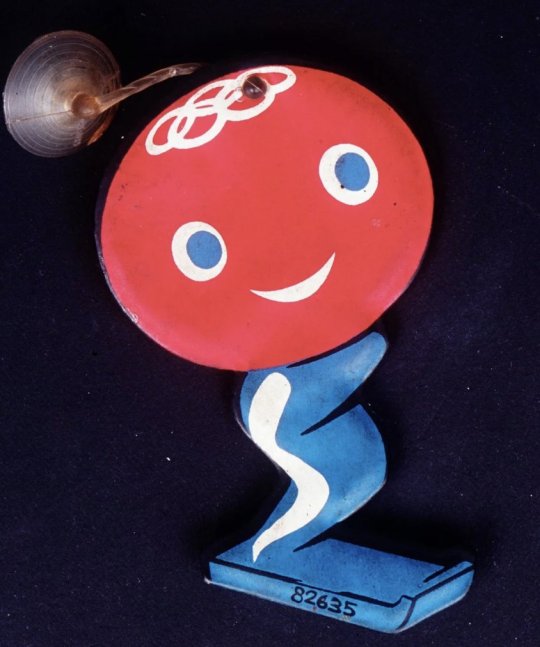

Learned today about the very first (unofficial) olympic mascot designed for the 1968 Winter Olympics in Grenoble, France. His name is Schuss and, according to the Olympics website, he was created in one evening. I like him a lot
#idk what to tag this!#olympic mascots#schuss#he is also called shuss#idk which is correct#irrelevance#edit: rearranged pics a bit
468 notes
·
View notes
Text

Suzy Chaffee photographed during the Winter Olympics, 1968.
Suzy is credited with starting the 1970s fitness craze, helping pass Title IX legislation, and inventing a new sport (inventing the sport of ski ballet or Freestyle). In her spare time, she acted, modeled, and designed skiwear.
16 notes
·
View notes
Text
[2024.08.30] Kateigaho 800th commemorative issue - Ryojun Shionuma x Yuzuru Hanyu: The Meaning of Life

"Unmoved by the eight winds, sitting upright on the purple lotus - The words of the soul that give life the power of enlightenment"
In the 800th commemorative issue of this magazine, a miraculous special conversation was realized. Ryojun Shionuma, the abbot of Jigenji Temple in Sendai City, Miyagi Prefecture, and Yuzuru Hanyu, a legendary figure skater who has repeatedly reached the peak of the figure skating world and has engraved his name and left countless milestones in its history. The two of them have always been regarded as the beacon of hope by people, and the profound yet light-hearted communication between them has the power to illuminate our way forward. The meaning of life, the way to accept pain, and other words of the soul that are relevant now will all be conveyed to you in this conversation.
[The most difficult pilgrimage, "Omine Thousand Days Trip to the Peak", completed by Ryojun Shionuma. The great Ajari Ryojun Shionuma was born in Sendai, Miyagi Prefecture in 1968. He is the abbot of Jigenji Temple. He graduated from Tohoku High School. He became a monk at Kinpusenji Temple on Mount Yoshino in 1987. He completed the Omine Thousand Days Trip to the Peak in 1999. He completed the Four No-Practices* (no food, no water, no sleep, no lying down for nine days straight) and the Great Goma Offering of 8,000 Pieces* (after abstaining from the five grains -rice, barley, wheat, red beans, soybeans, and salt for 100 days, one continues to burn 8,000 goma for 24 hours without eating, drinking, sleeping or lying down). In 2003, he established Jigenji Temple in his hometown of Akiu, Sendai. He has written many books. In June 2004, he published "Kurashi no Shio Kagen" at his own expense.] [Consecutive Olympic gold medallist and four-time Grand Prix Final champion - Yuzuru Hanyu. Yuzuru Hanyu was born in Sendai, Miyagi Prefecture in 1994. He is a professional figure skater. He graduated from Tohoku High School and Waseda University. Gold medalist of the 2014 Sochi Winter Olympics and the 2018 PyeongChang Winter Olympics. He is the first male singles athlete to win consecutive Olympic gold medal in 66 years. He is scheduled to appear in the "Noto Peninsula Reconstruction Support Charity Performance: Challenge!" on September 15, 2024 (no audience/live broadcast only).]
Precious words woven by two people who have experienced countless hardships.
[Dai Ajari and Yuzuru Hanyu, who decided on their current paths at a young age]
Dai Ajari Shionuma (hereinafter referred to as Shionuma): I’m happy to welcome Hanyu-san to Jigenji Temple again after a long time.
Hanyu-san (hereinafter referred to as Hanyu): I have been looking forward to seeing you again. It's great to see you unchanged.
Shionuma: This time, we will discuss important topics such as "What is the meaning of life?" and "What is life?". But when did you start to think about wanting to become the "Yuzuru Hanyu" that you are today?
Hanyu: I started skating at the age of four, and right away I was saying, 'I will win a gold medal at the Olympics.' It wasn't just that I wanted to; winning became a predetermined path for me. I was a strange kid (laughs).
Shionuma: Speaking of strange kids, can I share my story too? (laughs). I was in fifth grade when I saw a documentary about the "Thousand Days Journey to the Peak" on TV and thought, "I want to do that." I held onto that dream, and after graduating high school, I went to Mount Yoshino’s Kinpusen-ji for training. Even though I was still a novice, I was already convinced that I could definitely complete the 1,000-day pilgrimage. I was a strange kid, wasn't I (laughs).
Hanyu: But when you actually tried it, wasn’t it extremely tough?
Shionuma: Yes, it was very tough.
Hanyu: For me, too, the path was completely different from what I had imagined when I was a child. I had a much easier image of “I won a gold medal,” but it was really hard. Why do we humans tend to choose the difficult path? (smiles wryly)
Shionuma: Perhaps it’s because we continue to seek “truth.” When we face ourselves stoically, unnecessary things are stripped away, and our hearts become clearer. We also have guidelines like walking 1000 days or 48 kilometres a day, but those are merely training periods necessary for inner growth. This is exactly the difference between adventurers and explorers who are fascinated by nature and ascetics.
Hanyu: So, you push yourself for inner growth. When I'm doing physical training or strength training, it might feel somewhat similar to ascetic practice. Since becoming a professional figure skater, I've started to think more deeply about "expression," and I feel like I've been spending more time facing myself. I realised that I couldn't express the way I wanted to unless I really thought about who I am and what life is, and started to form my own core. I think there are some states of being that can only be seen when you are pushed to the point of no escape.
Shionuma: That's true. But unless you're engaged in work that requires you to raise your gear and efficiency for training or performance, it's probably better to live a life where you're not under too much pressure (wry smile).
Hanyu: That's right. However, I feel that being pressured with deadlines, such as tests and homework when you're a student, can help you develop concentration.
Shionuma: The experience of facing oneself when pushed to the limit may indeed be effective for awakening new insights and states of being.
Hanyu: I felt that I wasn’t truly myself unless I kept challenging myself, so I incorporated difficult moves with a success rate of 10% or 20% into my competitions. When I think back on why I got into skating, I believe it was because I could confront challenges within an extraordinary experience.
Shionuma: Once you experience success in the face of extreme difficulties, you can’t stop trying.
Hanyu: But to be honest, I still have dreams about failure. Recently I had a dream about a competition, and even though the start time had passed, I still hadn't put on my costume or skates. I was in a panic (wry smile).
Shionuma: Do you not have dreams about success?
Hanyu: I don’t have them often. But I did have a dream about successfully jumping a quadruple axel before. I remember thinking, “I did it now, but this is a dream. However, this feeling is so real, I should remember it... Oh, I’m starting to wake up, so I’ll do some image training for the quadruple axel once I’m up.” I approached it with that kind of enthusiasm, using the dream to its fullest. (laughs) How about you, Ajari-san? Do you dream of your training?
Shionuma: I still sometimes dream about walking in the mountains. I don't feel like the 1000-day pilgrimage has ended; each day feels like the 1000th day. In fact, I only wrote in my journal during my training up to the 999th day. I guess my training is still continuing somewhere in my heart.
[The state of mind I discovered and reached through writing in my diary]
Hanyu: Did you write in your diary every day?
Shionuma: Yes. I wrote every day until the 999th day without missing a single day. Before I started my 1000-day pilgrimage, I decided to write a white circle in my journal on days when I went to training with the mindset of "Let’s go!" despite any pressure or stress, and a black circle on days when I felt, "I don’t want to go today..." But there was not a single day when I went to the training with a negative feeling. They were all white circles. That’s what still gives me confidence today. Hanyu: That's amazing. Did writing down your thoughts give you the mental support of 'Let's do it again tomorrow!' or make you think that you had to change yourself?
Shionuma: That might be part of it. I also wrote down the feelings and realisations I had at the time every day so that I wouldn't forget them.
Hanyu: Ajari-san, I’m the same. You're completely an athlete (laughs). My skating coach told me, "Write down in your notebook on the same day how it felt to be able to jump if you did it this way," so I've been writing since I was little. I've had the habit of writing things down in my skating notebook since I was young, so I still write down things I notice.
Shionuma: I see. The reason your words, which express your inner thoughts, resonate with people all over the world is due to that accumulation. When you write in your skating notebook, do you often write with a positive mindset?
Hanyu: I think I should accept and acknowledge all negativity as negativity. It's not good to vent your negative feelings on others, so I write everything in my skating notebook. I write it, tear it up, throw it away, and that's it! That kind of pattern. I think I've thrown away as many worries as the number of pages in the notebook I tore up (laughs).
Shionuma: That's a good method. In Buddhism, the greatest enlightenment is to let go of attachments. The Zen phrase "Eight winds blow but I remain unmoved" really resonates with me right now. When the eight winds (prosperity, decline, disgrace, honour, praise, censure, suffering, and pleasure) that disturb our minds come, our minds are inevitably shaken. Of course, we may react and become disturbed temporarily. The important thing is not to be caught up in that for too long. The teaching is that the way humans should aim for in life is to let go (throw away, discard) everything and encounter a new state of being, and that is exactly what Hanyu has been doing. I will do it that way from now on too. I may end up writing a huge amount, thinking, "Am I really writing and throwing away all this in one day?" (laughs).
Hanyu: No way (laughs).
[Concentration that can only be achieved in extreme situations]
Shionuma: By the way, I was moved when I saw your solo performance "ICE STORY 2023 "GIFT"" held at the Tokyo Dome in February 2023, the first time in the history of skaters to do so. What is the driving force that allows you to perform in such extreme situations?
Hanyu: Because everyone has high expectations of me. That's the only reason. I'm currently putting on an ice show where I'm the only skater for over two hours, and it's because I'm pushed to the limit and have my physical and mental strength worn down that my performance can be filled with tenderness, or conversely, even create a bit of a destructive atmosphere. There are times when I find myself thinking, "Why am I trying so hard? What am I doing this for?" But the reactions and energy of the audience when I deliver my performance is really enjoyable and makes me happy. I do it because I want to experience that pleasure.
Shionuma: I wondered what this power is.
Hanyu: If I don't do that much, I can't perform in a way that moves people's hearts. To begin with, I don't have much confidence... Everyone says I'm "mentally strong," but it's precisely because I'm not strong that I have to practice and prepare a lot to be able to endure. Also, I was thinking recently, "Why am I called a narcissist?" As a skater, I have many opportunities to look in the mirror, but it's not like I like looking at it. Even when I'm asked to check the photos during a shoot, I don't really think I need to check my own face.
Shionuma: That's bad. Maybe I'm the narcissist... When my photo was taken just now, I said, "Show me the photo! It's good, it's good" (laughs).
Hanyu: Ahahah (laughs). I'm not confident to begin with, so I can't do things half-heartedly. For example, when I'm warming up, I often concentrate so much that I'm immersed in my own world. People tend to think that I'm "intoxicated with myself" because I'm not embarrassed when they see me lip-syncing enthusiastically, but it's not that I'm self-absorbed. I have to go that far to perform at my best. Maybe I'm labeled a narcissist because I go all out more than the average person...
Shionuma: In general, people only have access to a very limited amount of information, which can lead to an image that is perceived as completely different from reality.
Hanyu: Well~ I want to loudly refute the allegations that I’m a narcissist (smiles wryly)
Shionuma: Let me make it clear here. People tend to think that I must be a very special person for having completed the 1000-day pilgrimage, which only two people have succeeded in over 1300 years. However, I'm often told, 'When I meet you, you're just an ordinary person.' This makes me very happy.
[100-year-old active monk + 100-year-old active skater]
Hanyu: But I’ve been aware that I was a strange kid since I was little. Ajari-san must have been quite a strange kid too, deciding to do the 1000-day pilgrimage in fifth grade (laughs). If you could go back to the time when you first saw the 1000-day pilgrimage program, would you make the same decision again?
Shionuma: (answers immediately) Yes. Even if I were reborn, I will definitely embark on the same path again.
Hanyu: That’s amazing. I’d probably choose to take a different path if possible. If there is reincarnation, I would like to devote everything I can to skating in this life and complete it to the point where I feel like I've accomplished everything! Well, maybe I’ll be an ant in my next life (laughs).
Shionuma: Seriously, ant?! (laughs)! Right now, I enjoy every day from the time I wake up in the morning until I go to bed at night. Monks often do great work after they turn 80, but if you think of life as a mountain climb, then at 56 years old I'm still only at the second station. Since I was given this life, I feel I've been able to maintain a pretty good mental state, so I’ve decided to continue studying until I'm 80 and to keep working on the front lines until I’m 100.
And, this is just my own desire, but when I complete this life and move on to the next world, I want the gods, Buddha, and my teachers to say to me, 'You did well.' This is what motivates me to keep walking the difficult path I have chosen without giving up, in order to contribute to everyone's happiness. Hanyu-san, what are your thoughts on the meaning of life and your own role?
Hanyu: I think a lot about the meaning and role of my life. I don't go so far as to say it's for the sake of the world or for others, but I think the meaning of my life is to exist for someone. For me, that tool happens to be skating, and I feel that my current role is to connect with everyone through it.
Shionuma: I see. I said that I want to learn until I'm 80 and continue to work at the front line until I'm 100, but what do you want to do from now on, Hanyu-san?
Hanyu: Working on the front lines until 100? A 100-year-old active skater is amazing, isn’t it? (laughs) Right now, I’m in the midst of a transformation myself, so to be honest, this is the most unpredictable time for me... I can definitely feel the reality of living as I change rapidly. Since skating is a physical activity, I can’t predict when something might happen, including injuries, or how it might all end. However, I hope to live in a way that allows me to truly feel my own role and the meaning of my existence in each moment.
Shionuma: You’re experiencing change, I see. When difficult things happen, how do you face them?
Hanyu: I would let myself fall to the lowest point. After feeling exhausted, pained, and frustrated, I’ll then think, "Ah, let’s try my best." But I also think that without these difficult moments, it would have been hard to see hope for the future. Having experienced the Great East Japan Earthquake at 16, I’ve had many opportunities to visit affected areas, and I feel that many people compare their own pain to that of others and endure it by thinking, 'Compared to them, I'm not suffering as much.' While this is a virtue unique to the Japanese, I've been thinking lately that it’s okay to accept that pain is pain.
Shionuma: That's right. I think the only thing we can do is to acknowledge the pain and turn it into sustenance for moving forward.
Hanyu: I think so too. On the contrary, if you always say, "I’m not suffering," you may not have the strength to take the next step. That’s just the way it is, isn’t it?
[Acknowledging the pain gives you the strength to take the next step]
Shionuma: That’s true. Do you think you can accept your pain as it is and turn it into nourishment?
Hanyu: But I feel like my mental state is getting weaker every year. Is this what turning 30 feels like? It’s definitely different from my teenage years (wry smile).
Shionuma: Really? I’ve become more confident and positive now that I’m 56 (laughs). Sometimes unexpected obstacles or accidents occur. During those times, I make sure not to be passive. When something happens, I try to tackle it head-on. I believe that if I can overcome this pain and turn it into nourishment, I can definitely rise again. I think that kind of confidence is very important in life.
Hanyu: Impressive. Do you ever feel down?
Shionuma: I don’t feel down… (laughs) I’m moving around so much every day that I hardly have time to dwell on things. Of course, I feel deeply upset when I make mistakes or act inappropriately, but I try to quickly regain my composure and make amends. I want to maintain a positive mindset and stay on track.
Hanyu: I wonder if in another 20 years I’ll be able to reach a state where I’ll never feel down (laughs). Today, I had a lot of discussion with Ajari-san about how to face oneself and what it means to live. In this age of social media, where uncertain topics abound, and given the unstable global situation, I hope this conversation provides a chance to reflect on ourselves and offers insights to think about who we are and whether we can clearly discern the truth. I want to live with the belief that if one person changes, the people around them will change, the country will change, and the world will change.
Shionuma: Just as you said. Everyone, let's proceed with the mindset of "unmoved by the eight winds."
------------------------------------------------------------------------------
"Reflecting deeply about how to express (this issue) is also a consideration of the meaning of life." - Yuzuru Hanyu "Still learning at the age of 80, still at the forefront at the age of 100." - Ryojun Shionuma "I write down the negatives in a notebook and then tear it up; the number of pages torn represents the worries discarded." - Yuzuru Hanyu "Suffering can come to anyone, the only thing you can do is to accept it and turn it into sustenance for moving forward.” - Ryojun Shionuma [End of the conversation]
[Message to the other party]
Dai Ajari Shionuma to Yuzuru Hanyu: [Strong and gentle, mysterious and beautiful] “Although we haven’t met for many years, from his words, I can clearly sense that he has accumulated a wealth of experience and depth in his life. As a rare figure skater, the weight he carries on his shoulders is immeasurable, and I sincerely hope that this conversation can show the truest Yuzuru Hanyu, and convey his unique charisma that combines gentleness, resilience, and sensitivity. I sincerely hope that more people can gain inspiration about life from this, even if it is just one more person.
Yuzuru Hanyu to Dai Ajari Shionuma: [The meaning of existing here, the meaning of being yourself is ‘life’] “I came to visit with a teacher from Tohoku High School when I was a teenager. I was a little nervous when I first arrived, but Dai Ajari greeted me with a series of cold jokes, and it was the same this time (laughs). Sharing the significant growth and changes I’ve experienced over the years with him has been very reassuring, so we discussed many topics I had never talked about before. For those who read this conversation, I would be very happy if you could find some words that touch your heart and brings us closer together.
Source: https://www.kateigaho.com/article/detail/177647 Info: https://www.kateigaho.com/article/detail/177345
15 notes
·
View notes
Text
Beijing 2022

Obverse: The Olympic Rings and "XXIV Olympic Winter Games Beijing 2022" surrounded by traditional Chinese art of stars and clouds inside concentric circles. Reverse: A stylized depiction of the Solar System around the logo, marking the Games coinciding with Chinese New Year festivities
Grenoble 1968

Obverse: Three snowflakes and the red rose emblem of Grenoble surrounded by host details. Reverse: A stylised image of each sport
11 notes
·
View notes
Text
Lorne Michaels spent time in England after he graduated college. Dick Ebersol worked for ABC Sports as television's first-ever Olympic researcher, starting at the 1968 Olympic Winter Games in Grenoble, France.
What if they met while they were both in Europe? Obviously the time lines don’t match up exactly, but this is fiction anyway. Like I’m picturing Dick wandering around France, not really knowing much French, and he asks for directions from this random person on the street. And Dick is extremely relieved to discover this person *cough* Lorne *cough* speaks English.
#fun fact Dick is named after his mother’s maiden name#saturday night (2024)#ch: lorne michaels#ch: dick Ebersol#saturday night movie#plot bunnies#Lorne and Dick#lorne/dick
4 notes
·
View notes
Text
chemistry in sports, spandex

As temperatures rise, it’s time for water fun. Swimwear is essential, and spandex, known as “Lycra,” is a key fabric component. Invented by DuPont in 1958, spandex is an elastic fiber made from polyether-polyurea copolymers. It can stretch up to 600% and return to its original shape. It’s lightweight, smooth, durable, and static-free. In the 1968 Winter Olympics, French skiers first used spandex in their competition suits.
Due to its excellent elasticity, strength, wrinkle resistance, and quick-drying ability, spandex is widely used in sports apparel like tight-fitting garments, professional swimsuits, cycling gear, and gymnastics attire. In everyday clothing, spandex is added in small amounts to increase elasticity. For example, the elasticity in stretchy jeans comes from the spandex blended into the fabric.

4 notes
·
View notes
Text
currently obsessed with olympic pictograms so i'm rating them
simplified images of different sporting events/locations helped athletes and tourists navigate the country even if they didn't speak the language, resulting in a win for accessibility and graphic design everywhere. below are a few notable sets.

^1. London, 1948: 5/10. aggressively old-timey, but i like the figure drawings

^2. Mexico City, 1968: 10/10 love the color choice, love the waves, love the weightlifing
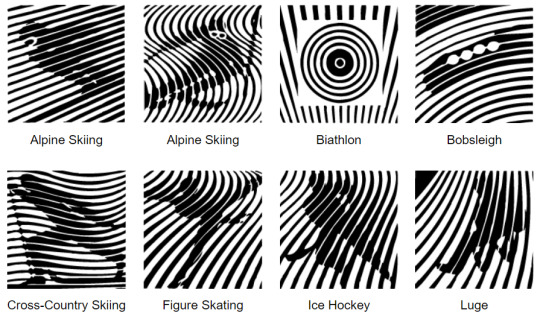
^3. Grenoble (winter), 1968: 9/10 a mild headache is worth it for the slay

^4. Munich, 1972: 4/10 not my favorite but set the precedent for future pictograms. the group shots are fun
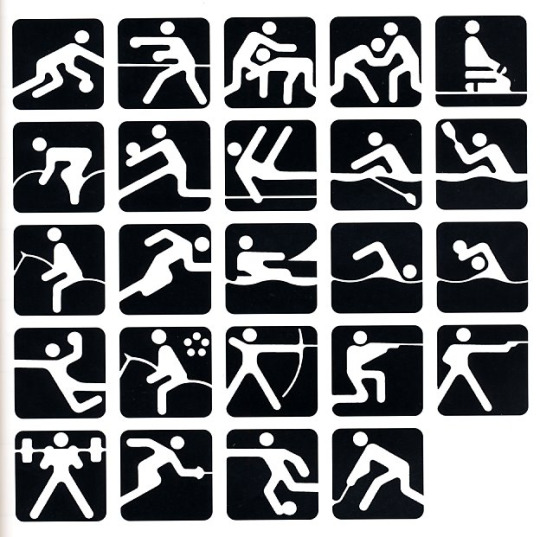
^5. Moscow, 1980: 6/10 munich plus wiggles :)
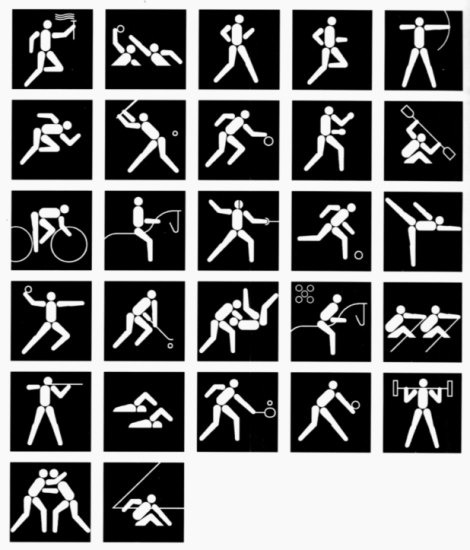
^6. Los Angeles, 1984: 4/10 they look like crash test dummies but points for good posture
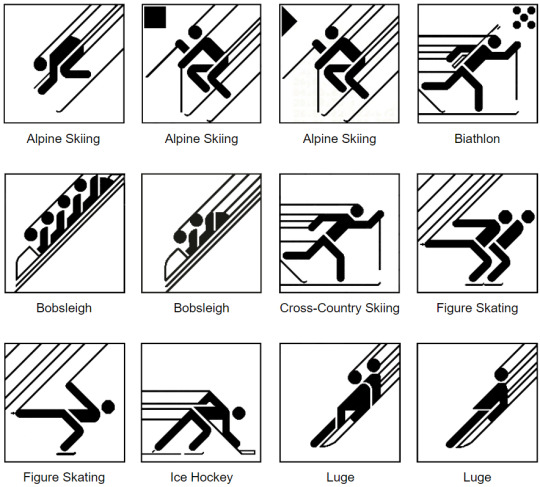
^7. Sarajevo (winter), 1984: 9/10 the additional lines give dynamism but don't distract from the central figures!!

^8. Barcelona, 1992: 7/10 i like the calligraphic influence
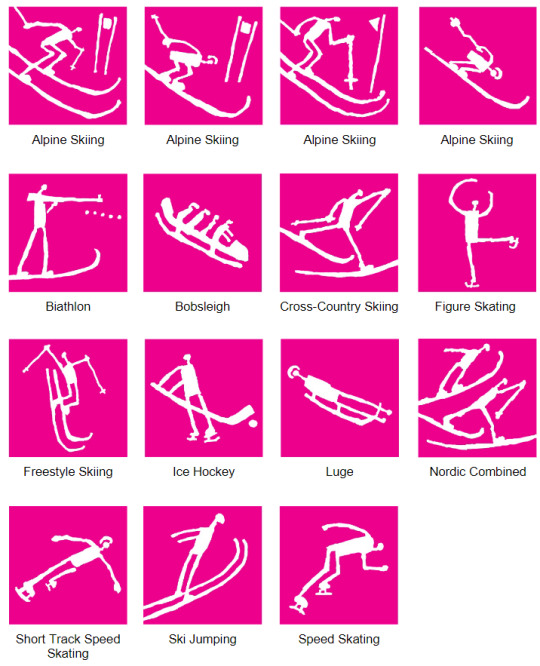
^9. Lillehammer (winter), 1994: 10000000/10 absolutely perfect little guys. actually it's one guy and he does all the sports


look at this shit it's delightful why did they keep changing pictograms after this when they obviously struck gold
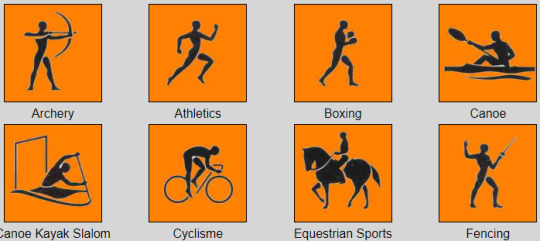
^10. Atlanta, 1996: 3/10 boring but points for being caked up
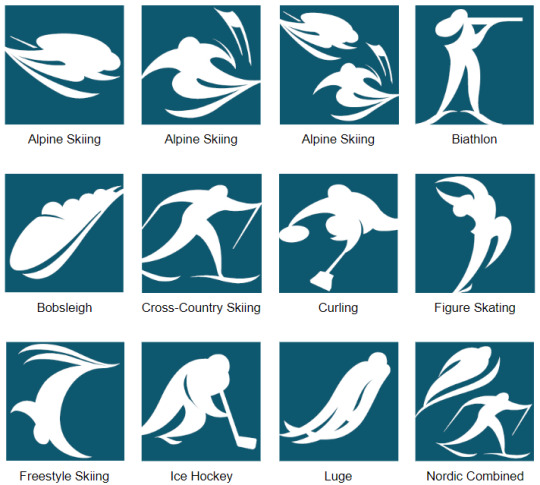
^11. Nagano (winter), 1998: 6/10 interesting paint-like strokes, deduction for luge which is actually a seeker of hermaeus mora come to kill me

^12. Sydney, 2000: 10/10 theyve all got little boomerangs :')
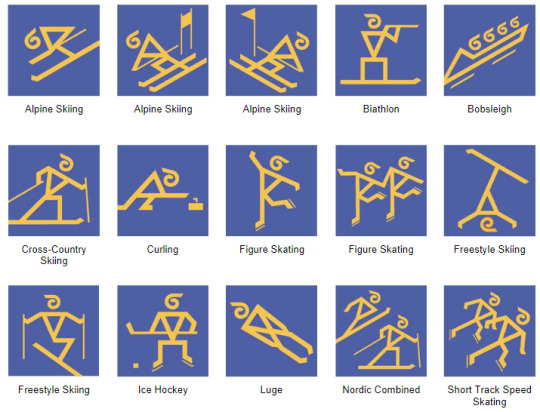
^13. Salt Lake City (winter), 2002: 5/10 based off cattle branding icons apparently? not my favorite but i have to respect the new direction



^14. Athens, 2004: 9/10 horrible cropping as to exclude their horrendous mascot but i love love LOVE when they take inspiration from the cultural history of a location!! in this case, cycladic figurines (pictured below)


^15. Turin (winter), 2006: 10/10 no notes i love it

^16. Beijing, 2008: 10/10 historical reference goes HARD
pictured: seal script, a predecessor to modern chinese lettering. you may recognize it from its use in avatar: the last airbender!

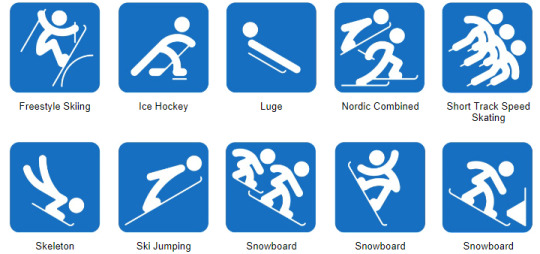
^17. Sochi (winter), 2014: 12/10 i love him he's just a fella. like that's my guy there he goes

^18. Beijing (winter), 2022: 8/10 i do like the calligraphic strokes but not as much as previous examples
HONORABLE MENTIONS


^equestrian events and kayaking at rio, 2016

^cycling at berlin, 1936 (all others were superimposed over the circle while this one fully incorporates it)

^biathlon at vancouver (winter), 2010: so fucking badass it's like a cartoon villain
Thank you for indulging my autism event :)
Links: Summer, Winter
10 notes
·
View notes
Text

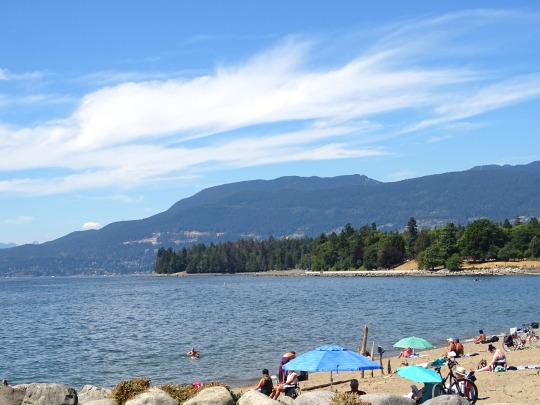



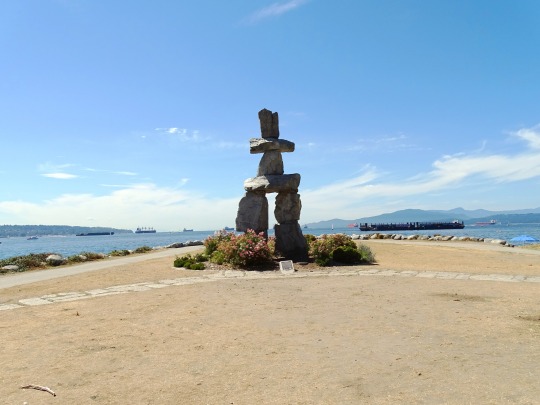



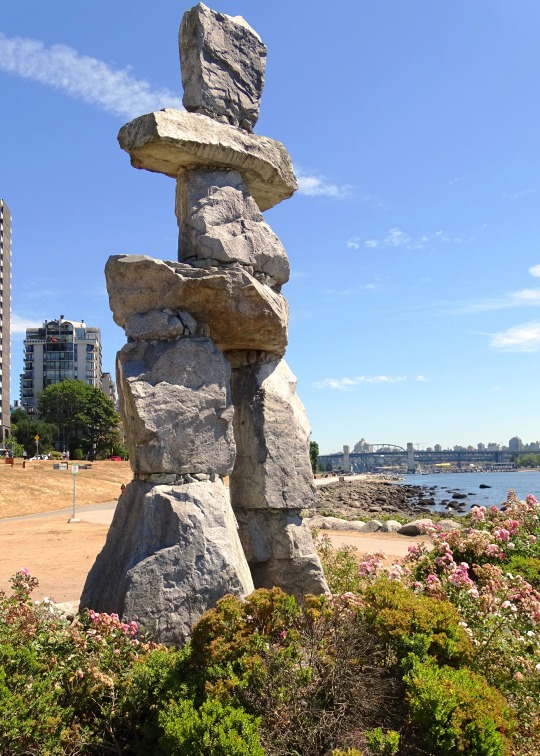
Vancouver Seawall (No. 8)
The False Creek area was the industrial heartland of Vancouver through to the 1950s, and was home to many sawmills and small port operations. As industry shifted to other areas, the vicinity around False Creek started to deteriorate. In 1960, BC Forest Products plant and lumber storage facility on the south side of False Creek caught fire in Vancouver's first-ever five-alarm blaze. Every piece of firefighting equipment and all of Vancouver's firefighters fought the blaze for hours, but the facility was totally destroyed.
Walter Hardwick, a geography professor at UBC, first elected to City Council in 1968, led the City's redevelopment team and helped secure the participation of the Federal Government, which owned Granville Island. A major public involvement and co-design process followed which established public priorities for an accessible waterfront seawall; mixed-tenure housing including market condominiums, co-op and low-income housing and live-aboard marinas; and a vibrant waterfront market. These plans were formalized in a 1972 Official Development Plan. The form and mix of development were revolutionary for Vancouver at the time. A third of the site was set aside for 40 units/acre housing with the balance converted to park, waterfront and community uses.
The North Shore of False Creek (NFC) was further transformed in the 1980s, as it took centre stage during Expo 86. Following Expo, the Province sold the NFC site to Hong Kong tycoon Li Ka-shing whose company Concord Pacific successfully marketed Vancouver in Asia, as a place for investment and migration. With the province enabling strata titles, a high-rise condominium boom soon followed, with Downtown Vancouver's population soaring from around 6,000 throughout the 1970s and 1980s to over 43,000 in 2006.
The 1991 Official Development Plan enabled significant new density commensurate with the provision of significant public amenities including street front shops and services, parks, school sites, community centres, daycares, co-op and low-income housing. Since then, most of the north shore has become a new neighbourhood of dense housing (about 100 units/acre), adding some 50 000 new residents to Vancouver's downtown peninsula.
On December 1, 1998, Vancouver City Council adopted a set of Blue ways policies and guidelines stating the vision of a waterfront city where land and water combine to meet the environmental, cultural and economic needs of the City and its people in a sustainable, equitable, high quality manner.
Southeast False Creek (SEFC) is the neighbourhood designated by Cambie, Main, West 2nd Avenue, and False Creek. The 2010 Olympic Village, for athlete housing and logistics of the Winter Olympics, is found in Southeast False Creek. As of 2021, the population exceeded 3,000.
Source: Wikipedia
#Inukshuk by Alvin Kanak#Vancouver Seawall#False Creek#downtown#Vancouver#BC#British Columbia#travel#original photography#vacation#tourist attraction#landmark#architecture#cityscape#Canada#summer 2023#tree#flower#detail#boat#ship#sand#flora#fauna#public art#beach#Douglas Coupland#The Berkeley#Eugenia Place#English Bay Beach
5 notes
·
View notes
Text
Events 2.20 (after 1940)
1942 – World War II: Lieutenant Edward O'Hare becomes America's first World War II flying ace. 1943 – World War II: American movie studio executives agree to allow the Office of War Information to censor movies. 1943 – The Saturday Evening Post publishes the first of Norman Rockwell's Four Freedoms in support of United States President Franklin Roosevelt's 1941 State of the Union address theme of Four Freedoms. 1944 – World War II: The "Big Week" began with American bomber raids on German aircraft manufacturing centers. 1944 – World War II: The United States takes Eniwetok Atoll. 1952 – Emmett Ashford becomes the first African-American umpire in organized baseball by being authorized to be a substitute umpire in the Southwestern International League. 1956 – The United States Merchant Marine Academy becomes a permanent Service Academy. 1959 – The Avro Arrow program to design and manufacture supersonic jet fighters in Canada is cancelled by the Diefenbaker government amid much political debate. 1962 – Mercury program: While aboard Friendship 7, John Glenn becomes the first American to orbit the Earth, making three orbits in four hours, 55 minutes. 1965 – Ranger 8 crashes into the Moon after a successful mission of photographing possible landing sites for the Apollo program astronauts. 1968 – The China Academy of Space Technology, China's main arm for the research, development, and creation of space satellites, is established in Beijing. 1971 – The United States Emergency Broadcast System is accidentally activated in an erroneous national alert. 1979 – An earthquake cracks open the Sinila volcanic crater on the Dieng Plateau, releasing poisonous H2S gas and killing 149 villagers in the Indonesian province of Central Java. 1986 – The Soviet Union launches its Mir spacecraft. Remaining in orbit for 15 years, it is occupied for ten of those years. 1988 – The Nagorno-Karabakh Autonomous Oblast votes to secede from Azerbaijan and join Armenia, triggering the First Nagorno-Karabakh War. 1991 – In the Albanian capital Tirana, a gigantic statue of Albania's long-time leader, Enver Hoxha, is brought down by mobs of angry protesters. 1998 – American figure skater Tara Lipinski, at the age of 15, becomes the youngest Olympic figure skating gold-medalist at the 1998 Winter Olympics in Nagano, Japan. 2003 – During a Great White concert in West Warwick, Rhode Island, a pyrotechnics display sets the Station nightclub ablaze, killing 100 and injuring over 200 others. 2005 – Spain becomes the first country to vote in a referendum on ratification of the proposed Constitution of the European Union, passing it by a substantial margin, but on a low turnout. 2009 – Two Tamil Tigers aircraft packed with C4 explosives en route to the national airforce headquarters are shot down by the Sri Lankan military before reaching their target, in a kamikaze style attack. 2010 – In Madeira Island, Portugal, heavy rain causes floods and mudslides, resulting in at least 43 deaths, in the worst disaster in the history of the archipelago. 2014 – Dozens of Euromaidan anti-government protesters died in Ukraine's capital Kyiv, many reportedly killed by snipers. 2015 – Two trains collide in the Swiss town of Rafz resulting in as many as 49 people injured and Swiss Federal Railways cancelling some services. 2016 – Six people are killed and two injured in multiple shooting incidents in Kalamazoo County, Michigan.
1 note
·
View note
Text








Arrivals & Departures 17 November 1938 – 01 May 2023 Gordon Meredith Lightfoot Jr.
Gordon Meredith Lightfoot Jr. CC OOnt was a Canadian singer-songwriter and guitarist who achieved international success in folk, folk-rock, and country music. He is credited with helping to define the folk-pop sound of the 1960s and 1970s. He has been referred to as Canada's greatest songwriter and his songs have been recorded by some of the world's most renowned musical artists. Lightfoot's biographer Nicholas Jennings said, "His name is synonymous with timeless songs about trains and shipwrecks, rivers and highways, lovers and loneliness."
Lightfoot's songs, including "For Lovin' Me", "Early Morning Rain", "Steel Rail Blues", "Ribbon of Darkness"��a number one hit on the U.S. country chart with Marty Robbins's cover in 1965—and "Black Day in July", about the 1967 Detroit riot, brought him wide recognition in the 1960s. Canadian chart success with his own recordings began in 1962 with the No. 3 hit "(Remember Me) I'm the One", followed by recognition and charting abroad in the 1970s. He topped the US Hot 100 or Adult Contemporary (AC) chart with the hits "If You Could Read My Mind" (1970), "Sundown" (1974); "Carefree Highway" (1974), "Rainy Day People" (1975), and "The Wreck of the Edmund Fitzgerald" (1976), and had many other hits that appeared in the top 40.
Several of Lightfoot's albums achieved gold and multi-platinum status internationally. His songs have been recorded by many notable artists. The Guess Who recorded a song called "Lightfoot" on their 1968 album Wheatfield Soul; the lyrics contain many Lightfoot song titles.
Robbie Robertson of the Band described Lightfoot as "a national treasure". Bob Dylan, also a Lightfoot fan, called him one of his favourite songwriters and said, "I can't think of any Gordon Lightfoot song I don't like. Every time I hear a song of his, it's like I wish it would last forever.... Lightfoot became a mentor for a long time. I think he probably still is to this day". Lightfoot was a featured musical performer at the opening ceremonies of the 1988 Winter Olympic Games in Calgary, Alberta and has received numerous honours and awards.
4 notes
·
View notes
Text
Grenoble Grenade Attack: 'Act of extreme violence': 12 injured in grenade attack at bar in Grenoble, France
A grenade attack at a bar in Grenoble, France, left 12 people injured on Wednesday night. The suspect remains at large, and authorities are actively investigating a possible link to organised crime.The incident took place in the Olympic Village neighbourhood, built for the 1968 Winter Olympics, when a man entered the crowded bar, threw a grenade, and fled without saying a word.A person came in…
0 notes
Text
Many injured in the rain between the French city of grambal
In the Southeast City of France, the Southeast City of Foods in a bar of the Southeast City of France explode in Canada. In the end of the lawyer, both the two people's serious situation told reporters that “many customers” while they the Grenad Olympic Village neighborhood. The beautiful city was explored in the 1968 Winter Olympics. Source link
0 notes
Text
Many injured in the rain between the French city of grambal
In the Southeast City of France, the Southeast City of Foods in a bar of the Southeast City of France explode in Canada. In the end of the lawyer, both the two people's serious situation told reporters that “many customers” while they the Grenad Olympic Village neighborhood. The beautiful city was explored in the 1968 Winter Olympics. Source link
0 notes